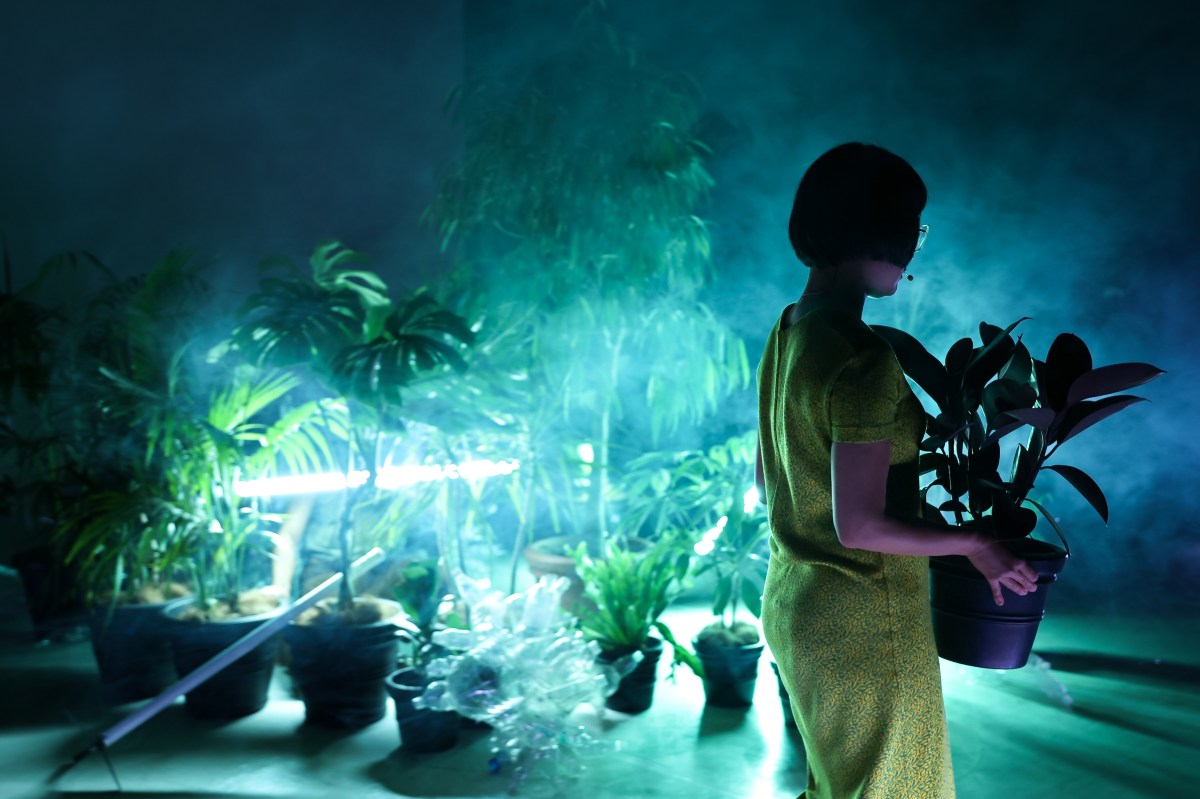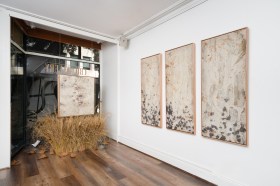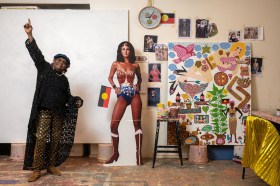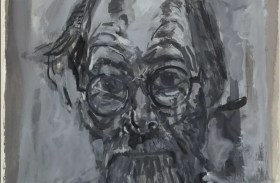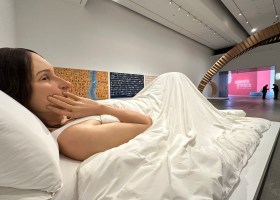Hundreds + Thousands is a performance installation in response to the current climate crisis. The trans-disciplinary work is created by collaborators and performers, Daniel Kok and Luke George, and premiered at the Perth Institute of Contemporary Arts (PICA).
The PICA Performance Space is filled with several and various living plants in pots: some seated as patrons on chairs, others as sentries to the entrance, others brought from home by ticketholders. A solo tree holds space centre stage. In the row before me, two men peer around a potted plant on the seat between them to have a conversation. Sweetly green anticipation builds as people wander in, some protectively holding their own pot plants. I sit next to a one-metre-high fern perched on a chair and am delighted to have a green companion for the performance. It’s an artful aesthetic and a strength of the work to be seated as an audience next to a patron plant.
Constant humming noises forms the soundscape. Daniel Kok walks slowly on set carrying a vertical light which he places next to the central potted tree. He is wearing a sheer floor-length patterned shift and his fingertips and toes are painted yellow. Kok continues to walk the perimeter of the space, carrying or dragging in other kinds of potted plants and more vertical fluorescent lights, his pace unhurried. He carries the plants with reverence, his movement gently measured. The plants are languidly arranged and rearranged in the space.
Luke George walks from the audience, rising from a seated position and holding a potted plant. George joins Kok in retrieving pot plants from the edges of the performance space or audience seats. Nigel Brown’s sound design undergirds the pedestrian movement.
Alice Hui-Sheng Chang slowly joins the evolving configuration of plants, mobile lights, and people moving through the dimly lit space. At one point, Chang removes the plant seated between the two men in the row in front of me and I feel the loss of something cut down, removed. Later, my companion fern is taken, and I remain conscious of the absence of slender fronds until I too leave.
The soundscape continues to build as installed lights flare brightly, trees and plants lit artificially. Time slows as plants are removed and moved for an extended length of performance time.
Eventually, all three human performers sit amidst the constructed garden, small bodily gestures framed by flickering lights and enhanced by fractured sounds.
Kok and George start bringing in sculptural forms made of empty water bottles. The constructions are interesting albeit obvious shapes: contorted, stuck statements of humans’ impact on ecosystems.
Chang begins to overlay the recorded soundscape with her own vocal sounds. Her face remains motionless; her voice is breathy and increasingly agitated. Then blackout. Darkness. Chang’s voice resonates over crackling sounds as the volume intensifies. Lights like laser beams trace the shape of plants, smoke machines fill the room with haze. An eerie green wash permeates the haze as audience members disappear into smoke.
Chang yelps and cries, Kok and George shake the plants: a frenzied disturbance. The wail of a human voice over distorted soundscape builds with the reconfiguration of objects in the space. There is descent into howling and distress as strobe lights assault the viewers engulfed in smokey haze. Chang screams. A red wash reminiscent of fire alludes to an apocalyptic end to the age of the Anthropocene. Chang tilts the original tree, so it is horizontal to the ground; her voice is piercing, screeching agony.
The experience is physically painful. Some audience members close their eyes against the strobe lights, others cover their ears. The smell of smoke lingers in nostrils. Reverberation of noise as a discomfort eventually petters out and we are left with silence: a relief and reprieve. Chang takes deep, prolonged breaths in the ecological ruin of a more-than-human world.
Kok approaches an audience member who holds her own plant and invites her onto the stage. The participant then rests on her back, her plant perched on her stomach. As other audience members and their plants are invited to become part of the installation, George appears costumed in plastic debris, dragging colourful remnants of human civilisation across and through the construction of plants and peoples.
As the performance ends, all audience members are invited to leave their seats to walk among the installation. The participatory element holds potential for reflection on all living things as being interconnected.
Read: Performance review: PENDULUM, Melbourne Fringe
Hundreds + Thousands presents as a posthuman lament. The bare-footed performers move as though oblivious to others; their faces remain impassive throughout the performance installation. The beginnings of participatory practices between peoples and plants are hopeful, though liminal, leaving traces of possibilities unrealised. The experience is visceral and likely to divide audiences, the thematic material a critical provocation for considerations of our responsibilities in the world.
Hundreds + Thousands – Daniel Kok and Luke George
PICA Performance Space, Western Australia
Presented by PICA and Performance Space (Sydney)
Lead artist/ Choreographer/ Performer: Daniel Kok and Luke George
Vocalist: Alice Hui-Sheng Chang
Sculpture Design: Leeroy New
Sound Designer: Nigel Brown
Lighting Designer: Matthew Adey
Production Manager: Nicholas Tee
Stage Manager: Stella Cheung
Technical Operator: William Gammel
Hundreds + Thousands was installed and performed from 13 – 15 October 2022.
